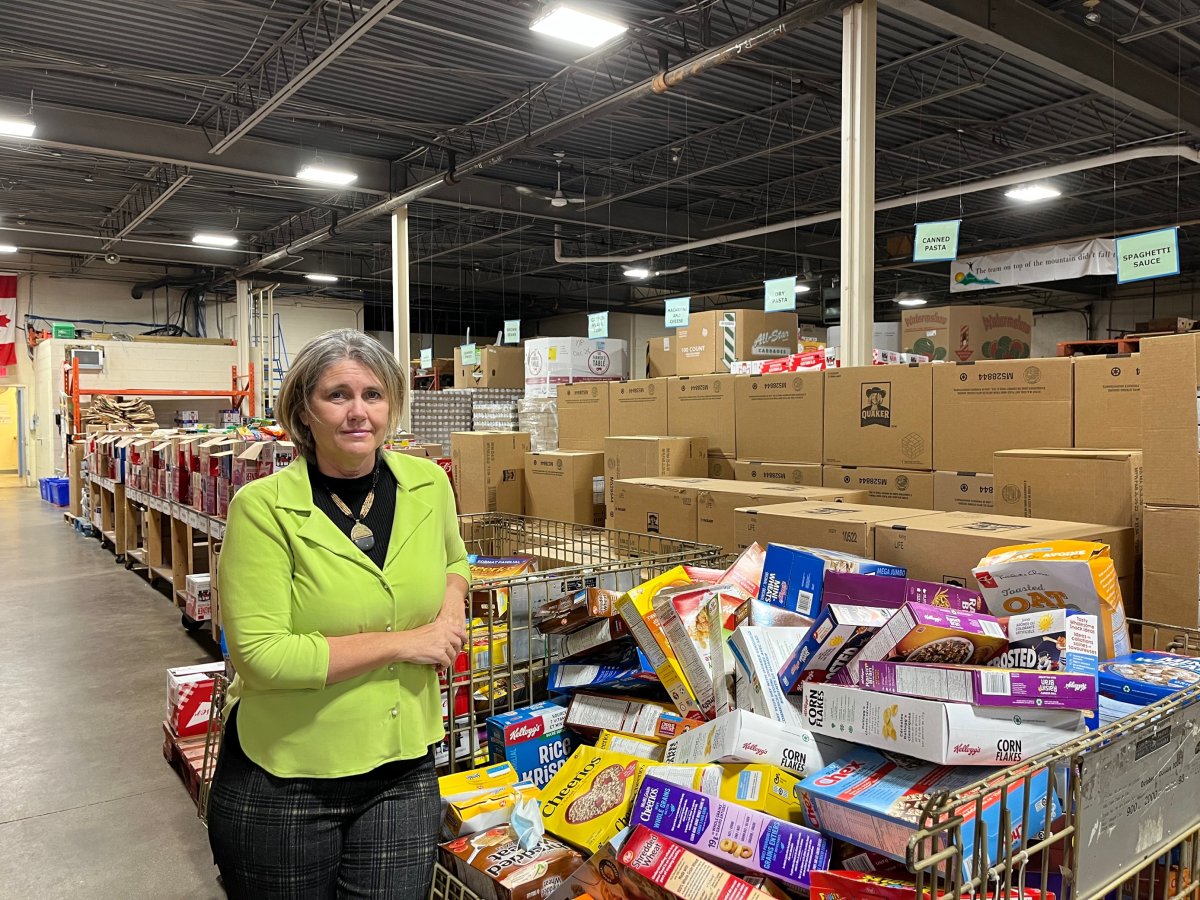As the London Food Bank marks the return of its annual fall food drive, food bank officials are sounding the alarm about unprecedented levels of demand from the community, including a surge in people who are new to the food bank.

The 34th annual Thanksgiving food drive, which begins Sept. 30 and runs until Oct. 10, comes as residents across the country grapple with growing inflation and higher housing, food and fuel costs amid relatively flat wages.
So far 23,157 different individuals, or 9,271 households, have used the food bank’s services at least once this year, a 41 per cent jump over the same period last year, agency figures show. Thirty-nine per cent of individual clients are minors.
In addition, about 28 per cent of all households helped by the food bank this year, nearly 2,800 families, are newcomers, up from 18 per cent last year.
“We’ve been around for 36 years. Three of our busiest months ever in our history have happened in the last four months,” Jane Roy, the food bank’s co-executive director, said on Thursday.
“We’re now seeing over 4,000 families a month right now. It’s been so difficult. And then when you look at the numbers of people who have never been to us before, those have doubled in the past year.”
- ‘Shock and disbelief’ after Manitoba school trustee’s Indigenous comments
- Canadian man dies during Texas Ironman event. His widow wants answers as to why
- Several baby products have been recalled by Health Canada. Here’s the list
- ‘Sciatica was gone’: hospital performs robot-assisted spinal surgery in Canadian first
Last month, the country’s annual inflation rate slowed to 7.0 per cent, driven by a dip in gasoline prices; however, grocery costs continued to rise.
In its monthly consumer price index report, Statistics Canada said last week that grocery prices rose in August at the fastest rate since 1981, with prices up 10.8 per cent compared with a year ago. The federal agency attributes the acceleration in food prices to continued supply chain disruptions, the Russian invasion of Ukraine, extreme weather and higher input costs.
While grocery prices rose nearly 11 per cent, average hourly wages ticked up 5.4 per cent in August, Statistics Canada said.
“Food banks were born in recessions during the 1980s. We’ve had five or six recessions since, so you kind of know them and know how to prepare. This one is kind of like that first recession. We have no idea what’s coming,” said Glen Pearson, the food bank’s co-executive director.
“We’ve got people who used to donate to us who are now coming for help, but they’re working.”
With so many Londoners feeling the financial crunch, those who may have helped contribute to previous food drives may, understandably, find it harder, if not impossible, to do so now.
“What do you do as a food bank? Do you sit there and prime the pump and guilt them into it? Of course you don’t,” Pearson said.
“If you’ve got an abundance, give more than you gave in other years … but if you don’t have it, don’t give it. As a food bank, we don’t want to see your family suffer so that you can help other families.”
According to Roy, the food bank isn’t setting a firm goal for this year’s fall campaign, noting that the 2021 drive was more focused on financial contributions over physical donations as a result of the COVID-19 pandemic.
This year’s campaign is a return to a more traditional drive like that seen before COVID-19. With rising food costs, food banks are finding that the monetary donations they receive don’t go as far as they used to.
During last year’s fall drive, every $2.60 donation equalled one pound of food, according to Food Banks Canada. Now, that pound of food costs $3.21, Roy says.
The impact of that change is evident when looking at the monetary donation tally from last year’s fall drive — $108,701. Previously, that would have translated to roughly 41,800 pounds worth of food. Today, it would equate to just under 33,900 pounds.
“We know that money doesn’t go as far. So, whatever happens will be great. We know the public will give what they can,” Roy said.
The drive doesn’t just help those turning to the food bank for help. About 70 per cent of poundage collected goes to the more than two dozen local organizations the food bank supports.
In addition, the food bank is the primary funder of the Middlesex-London Health Unit-led Harvest Bucks program, which sees vouchers distributed to the community to purchase fresh produce at participating organizations, including the Covent Garden Market.
Officials ask that those donating contribute non-perishable items with a focus on healthier options, such as canned fruits and vegetables with no added sugar or salt and low-salt pasta sauce; protein, such as peanut butter, canned or dry beans, and canned salmon or tuna; and grains, including low-sugar cereals, oatmeal, pot barley, whole grain pasta or brown rice.
“The one item that’s starting to be requested more and more … kids’ snack foods for schools. That tends to be expensive. Whatever is on sale, make your dollar stretch, we can use it,” Roy said.
Other needed items include baby formula, baby food, powdered milk and pablum, the food bank says, along with non-food items like toiletries.
Roy asks that those donating refrain from bringing in old or expired food and things that are homemade.
Non-perishable donations can be dropped off at grocery stores in the London area, at any of London’s 14 fire stations, and at the food bank’s warehouse at 926 Leathorne St.
Fresh food donations should be brought directly to the food bank.
Monetary donations and donations to the Harvest Bucks program can be made through the food bank website.
— with files from Andrew Graham and The Canadian Press








Comments